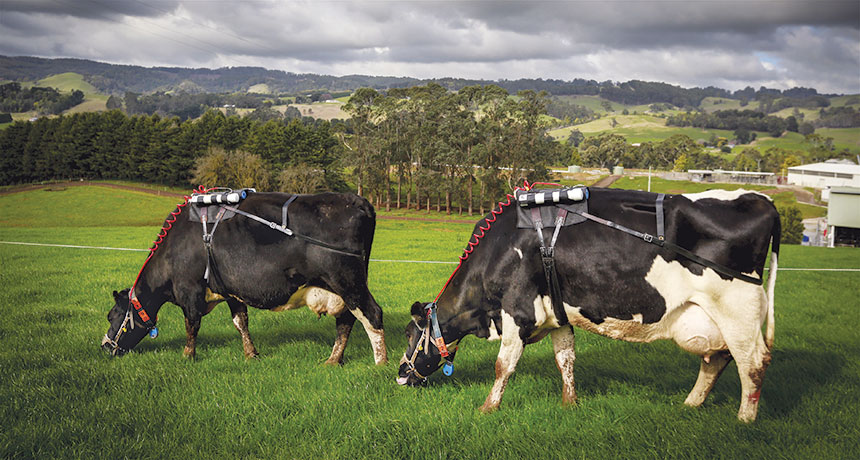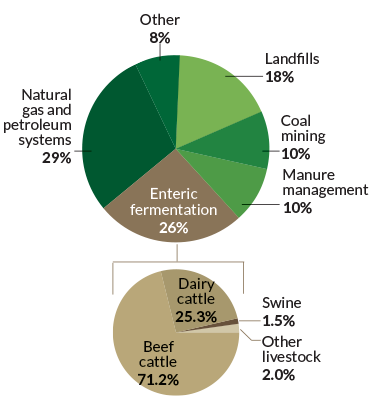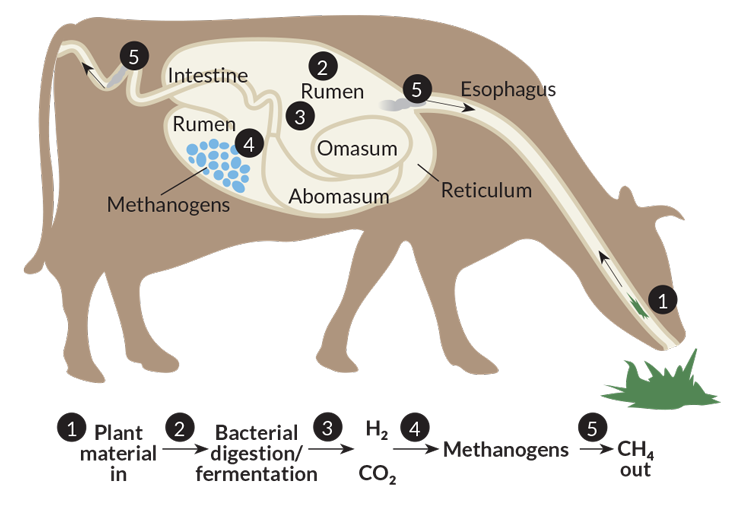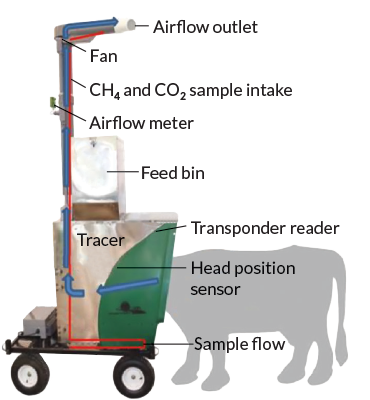
GREENER COWS These cows at the Ellinbank Dairy Research Centre in Victoria, Australia, wear backpacks that measure their methane output.
Eddie Jim/Fairfax Syndication
In a pasture outside Edmonton, Canada, you’ll find a few dozen cows doing what cows do: mostly eating. The average animal spends eight-plus hours a day filling its belly, or as is the case with cows, bellies. Along with that enormous appetite, cows are born with the ability to digest almost any plant they can chew, thanks to a multichambered stomach and a helpful army of gut microbes that break down food that most mammals cannot.
The system is an evolutionary bonanza for cattle, but it’s not so easy on the environment — which is why the animals at the Lacombe Research Centre are no ordinary grazers. Through a transponder clipped to the ear of each cow, scientists record when a cow sticks her head into a bin of tasty feed pellets. As she eats, a solar-powered fume hood above captures her exhalations. Laser beams surround the pasture, reading gases in the atmosphere.
All this fuss is over bovine burps. While cattle and other ruminants like sheep and goats have been gassy for around 50 million years, scientists have only recently begun to pay keen attention to their exhaust as concern grows over climate change. The belches contain methane, an odorless compound that is the main component of natural gas. In the atmosphere, methane warms the Earth.
It isn’t the most abundant greenhouse gas created by human activity (that prize goes to carbon dioxide), but methane is one of the most powerful at trapping heat. In a “pound for pound” comparison, over a century, methane has an impact on climate change that is 25 times as great as CO2, according to the U.S. Environmental Protection Agency.
Citing methane’s impact, a recent CNN story referred to beef as “the new SUV.” But the old SUVs, along with the rest of the oil and gas industry, are a larger source of atmospheric methane in the United States, EPA data indicate, contributing 29 percent of U.S. methane emissions. Livestock is responsible for 26 percent, the agency estimates. Yet while that’s the official number, a paper last year in the Journal of Geophysical Research: Atmospheres raised the possibility that the EPA’s measurements are off, and that the biggest source of methane from human activity may in fact be ruminants — more than 90 percent of them cows raised for beef and dairy production.
While methane emissions from the energy sector declined between 1990 and 2013, the contribution from agriculture rose by 11 percent, according to the EPA. (Though in later years cattle populations fell and so did livestock-related methane.) The World Bank estimates that overall global methane emissions rose 17 percent between 1990 and 2010. In 2014, the U.S. government announced a goal to reduce methane output from dairy cattle by 25 percent by 2020.
We summarize the week's scientific breakthroughs every Thursday.
That’s why scientists worldwide are looking for ways to produce a less noxious cow. Experiments target the animal inside and out, testing variations in feed, antimethane additives and experimental vaccines. The Canadian project goes deeper, using genetics to develop and breed animals that are naturally less burpy.
All approaches are promising, but no single one has hit the sweet spot: reducing methane dramatically while not harming the cow or dampening production of farms and ranches. Any solution can’t be too impractical or too expensive, either.
The good news is that this is one issue where the interests of the $44 billion beef industry and environmentalists may converge — cattle that pollute less might live longer or get by with less feed, improving the profit margins of farms and ranches.
“We’ve been selling the greenhouse gas story as a win-win to farmers,” says Conrad Ferris, head of dairy research at the Agri-Food and Biosciences Institute in Hillsborough, Northern Ireland.
Natural gas
Most methane-reducing experiments don’t concern the cow per se; they go after the microscopic ecosystem huddled inside the animal’s gut. When a cow eats, hay, grass and other plant material land inside the rumen, the largest of the four compartments of the bovine stomach, which can hold 150 to 190 liters of food and water. Ruminant digestion is a microbial marvel: A portion of the stomach is sectioned off into a sophisticated vat for fermentation, which occurs when microorganisms slice sugar and other large molecules into smaller ones. (Without fermentation, grapes and agave couldn’t become wine and tequila.)
Trapped inside the rumen, bacteria digest the components of the forage, especially cellulose, the large chains of glucose that form the main structural support of the cell walls of plants. Cellulose is the reason green plants tend to be stiff and rigid. People aren’t born with the enzymes to cope with cellulose, which is why we don’t eat grass. When humans eat foods such as fruits and vegetables, the cellulose acts as dietary fiber. Because it resists digestion, cellulose doesn’t provide energy. It does help a person feel full with fewer calories and maintain the health of the intestine, and of the microbiome inside.
But a ruminant animal’s microorganisms can extract the energy locked up in cellulose. Its digestive system includes microbes called methanogens, ancient entities distinct from bacteria and other microorganisms. Methanogens can live in other oxygen-starved environments, such as the bottom of lakes. When microbes in the rumen digest cellulose, they leave behind nutrients that the cow needs plus methane gas, created when methanogens soak up the hydrogen left over from fermentation. The relationship is straightforward: The more the cow eats, the more it ferments, the more methane produced.
Emissions from a grown dairy cow can amount to about 260 to 650 grams of methane per day. Consider that the nation has 98 million head of cattle and you see the scope of the problem. One mid-sized animal could put out about 150 kilograms of methane every year, which has the same environmental impact as driving from New York to Los Angeles — three times.
Fiddle with the feed
Scientists are trying to interfere with the chemical steps that lead to methane production in ways that don’t harm the overall health or productivity of the cows. Over the last few years, researchers have tried adding natural and laboratory-made substances to cow feed. One of them is nitrate. The idea is that, given the extra nitrogen, methanogens sopping up excess hydrogen will form ammonia (composed of one nitrogen and three hydrogen atoms) instead of methane (one carbon and four hydrogens). Last year, scientists from the Lethbridge Research Centre in Canada, writing in the Canadian Journal of Animal Science, reviewed nitrate-adding experiments dating back to the 1960s. Some laboratory tests yielded dramatic results, reducing cow methane emissions by as much as 70 percent. In other studies, the nitrate didn’t affect the growth or appetite of the cows, or milk or meat production.
Problem is, in the rumen, nitrate is broken down into nitrite, which can interfere with the action of red blood cells. One cow died in an experiment and six others had to be rescued. “One of the challenges is, how do you deliver it in a way that prevents nitrate toxicity in the animal,” says Wendy Powers, director of environmental stewardship for animal agriculture at Michigan State University in East Lansing.
Other scientists have experimented with plants that can influence microbes and change the methane-producing chemistry of the rumen, with the hope that “the public will more readily accept something that is natural,” says Alexander Hristov, a professor of dairy nutrition at Penn State University. He and his colleagues added a by-product of cashew nut processing to feed and reduced methane emissions by a modest 8 percent, they reported in June in the Journal of Dairy Science. He has also experimented with adding oregano to feed, which reduced methane. But it got to be too much. “We were feeding 500 grams of oregano per cow per day,” he says. “That is not going to be economical.”
Powers mentored a Michigan State grad student who tried adding an extract from tea to feed, which raised yet another complication: “You had to get so much in there to be effective, palatability became an issue,” she says. Cows will shun a solution that tastes bad. Overall, she says, experiments with various plant extracts have been inconsistent.
Hristov’s team devised another approach that appears to pass the taste test. Researchers experimented with a synthetic feed additive designed to interfere with an enzyme that drives the last step of methane formation. In the Aug. 25 Proceedings of the National Academy of Sciences, the researchers reported that 48 cows given the additive for 12 weeks produced 30 percent less methane than cows that ate only their normal feed. The additive did not affect the animals’ appetite or milk production. “This is the most promising feed additive we have worked with,” Hristov says. “In my opinion, this is the answer to the gut problem.”
The Irish scientists are also trying to reduce methane by decreasing the proportion of roughage (the grass and hay that leads to methane production) and increasing the amount of concentrates, which are plants that are easier to digest without fermentation, such as corn and soybeans. Last year, in the Journal of Dairy Science, the researchers described one such experiment in 40 grazing cows. As concentrates increased, so did milk production. The cows’ overall methane emissions weren’t affected, but with higher production, the amount of methane that accompanied each liter of milk was reduced, which eases the environmental impact. That experiment was on animals in the field. Experiments in barns have also demonstrated that more concentrates mean less methane per liter of milk produced, Ferris says. But concentrates are costly. “There comes a point when even the higher milk production doesn’t cover the cost of concentrates,” he says. Also, if the overall goal is to ease the impact on the environment, the production and shipping of concentrates has its own carbon footprint.
Squelch the belch
A concern with food additives is that the methanogens in the rumen might adapt to their new diet after a time and resume methane production at the same level. For that reason, an additive would probably need to be repeatedly fed and monitored through the animal’s life span, potentially adding to cost and labor, says Mark Aspin, manager of the Pastoral Greenhouse Gas Research Consortium in Wellington, New Zealand, which partners with the government research agency AgResearch. Researchers in New Zealand — a country with more cows than people — are developing an antimethane vaccine that could reduce the population of methanogens in the rumen without affecting an animal’s weight, milk production or breeding.
The advantage of a vaccine, Aspin says, is that it could theoretically be administered just once, or at least only annually. Also, farmers and ranchers are used to vaccinations; adding one more shot wouldn’t be much of a burden on existing agricultural practices. It could be used across other economically important ruminants, such as sheep (which outnumber his country’s human population 7-to-1), he says.
The technology is still far from the farm, however. The New Zealand research team has identified antibodies to the gut microbes and is in the process of amplifying the important pieces of those antibodies and incorporating them into a vaccine. In the journal Animal in 2013, the New Zealand team reported finding genetic sequences in methanogens that are attractive targets for a vaccine.
They’ve also developed a vaccine injection that produces methanogen antibodies in saliva, which would then travel into the rumen. This is one key to delivery, since an average cow produces 100 to 150 liters of spit a day to aid in digestion.
Further experiments would have to demonstrate that lowering methanogens won’t affect the animal’s overall health. “The concern is that removing methanogens from the rumen may allow hydrogen to accumulate,” Aspin says. However, “in the limited studies that have been done to date, it doesn’t appear that this is the case.”
Milking the genetics
Sidestepping digestion altogether, some researchers are focusing on breeding a cleaner cow.
In Ireland, Ferris and his colleagues experiment with livestock management. Part of the idea is to lengthen the life span of any given animal. “It takes over two years from when a calf is born until she produces her first liter of milk,” he says. If a cow lives longer, her lifetime methane production is spread out over more liters of milk. Also, a farmer does not have to replace as many members of the herd with young, all-methane, no-milk youngsters. In a paper published last year in the Journal of Dairy Science, his research team reported that Norwegian breeds had greater longevity than Holsteins, which make up more than 80 percent of U.S. dairy cows.
Researchers in Alberta are developing lines of cattle that produce less methane because they are born that way. “If you use a feed additive, you’ve got to add it all the time,” says John Basarab, a research scientist for beef cattle production and genetics at Alberta Agriculture and Forestry. But a naturally more efficient cow can get by on less feed for the same growth.
Over the last two decades, Basarab and his research team have measured about 5,000 cattle for feed efficiency, and report that old-fashioned selective breeding can produce animals that release up to 25 percent less methane. “In every breed there are animals that are efficient, or inefficient,” he says. The researchers began the research not with methane in mind, but with the idea that animals that extract the most calories from their feed will ultimately be more economical. “Essentially there are animals that eat less for the same amount of growth,” Basarab says.
Approaching the methane issue through genetics is slow (the gestation period for a cow is about 280 days), he concedes, but it also has the advantage of being “cumulative and permanent.”
He and others say the day may come for cows — just as it did for cars — when governments require certain limits on emissions. And just as organic foods have risen in popularity, consumers may start demanding low-methane products.
More and more consumers want to know where their food comes from and whether it’s being produced in a sustainable way, Basarab says. “If you don’t take care of these things, the public might just say that’s a bad way of producing food and we’re not going to buy it.”









